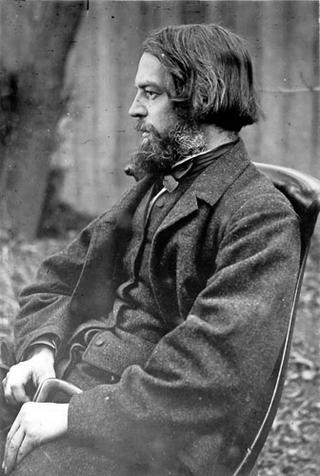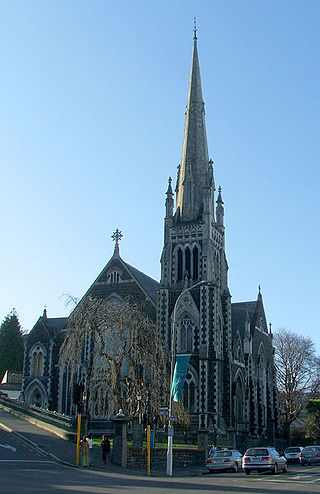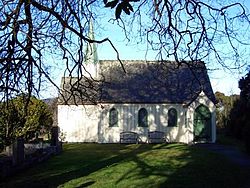
First Church is a prominent church in the New Zealand city of Dunedin. It is located in the heart of the city on Moray Place, 100 metres to the south of the city centre. The church is the city's primary Presbyterian church. The building is regarded as the most impressive of New Zealand's nineteenth-century churches, and is listed by Heritage New Zealand as a Category I structure.

Holy Trinity Cathedral is an Anglican cathedral church situated in Parnell, a residential suburb of Auckland, New Zealand. It is the 'mother church' of the Anglican Diocese of Auckland and the seat of the Bishop of Auckland. The current main church building was consecrated in 1973.

The Diocese of Dunedin is one of the thirteen dioceses and hui amorangi of the Anglican Church in Aotearoa, New Zealand and Polynesia.

Benjamin Woolfield Mountfort was an English emigrant to New Zealand, where he became one of the country's most prominent 19th-century architects. He was instrumental in shaping the city of Christchurch's unique architectural identity and culture, and was appointed the first official Provincial Architect of the developing province of Canterbury. Heavily influenced by the Anglo-Catholic philosophy behind early Victorian architecture, he is credited with importing the Gothic revival style to New Zealand. His Gothic designs constructed in both wood and stone in the province are considered unique to New Zealand. Today, he is considered the founding architect of the province of Canterbury.

St Joseph's Cathedral is the cathedral for the Roman Catholic Diocese of Dunedin. It is located in City Rise in the city of Dunedin, New Zealand. It serves as the seat of the bishop of the Latin Church Diocese of Dunedin, which was erected on 26 November 1869.

Holy Trinity Church is an heritage-listed Anglican church located in Port Chalmers, Otago, New Zealand. Completed in 1874, the Academic Gothic Revival church building is constructed in volcanic stone and has some fine stained glass, and is listed as a Category I Historic Place by Heritage New Zealand. Together with St Barnabas Church, Warrington, Holy Trinity Church is part of the Port Chalmers-Warrington Parish of the Diocese of Dunedin.

St Paul's Cathedral is an Anglican cathedral church located in the heart of The Octagon near the Dunedin Town Hall and hence Dunedin, New Zealand. The cathedral is the seat of the Bishop of Dunedin and the mother church of the Anglican Diocese of Dunedin.

Hanover Hall is a community arts centre and event venue in central in Dunedin, New Zealand, opened in 2018 as home to the Dunedin Symphony Orchestra. The building was built in 1912 as the Hanover Street Baptist Church, located in Hanover Street 1 kilometre (0.62 mi) northeast of the city centre, close to the Otago Medical School.

St Barnabas Church is an Anglican church in Hove, part of the English city of Brighton and Hove. It was built between 1882 and 1883 to serve residents of the newly developed streets to the south and west of Hove railway station, which had opened in 1865 and had stimulated growth in the previously undeveloped area between the Brunswick estate to the west and Cliftonville to the east.

St Barnabas' Church is in the town of Bromborough, Wirral, Merseyside, England. The church is recorded in the National Heritage List for England as a designated Grade II* listed building, and stands within the boundary of the Bromborough Village Conservation Area. It is an active Anglican parish church in the diocese of Chester, the archdeaconry of Chester and the deanery of Wirral South. The authors of the Buildings of England series describe it a "handsome church for a village-gone-prosperous". It is considered to be a well-designed example of the work of Sir George Gilbert Scott. In the churchyard are three Anglo-Saxon carved stones which have been reconstructed to form a cross.

St Mary's Church is the Anglican parish church of Lymm, Warrington, Cheshire, England, standing on a bank overlooking Lymm Dam. It is a grade II listed building. It is an active church in the diocese of Chester, the archdeaconry of Chester and the deanery of Great Budworth.

St Peter's Church is the parish church of Lymm in Warrington, Cheshire, England. The church is recorded in the National Heritage List for England as a designated Grade II listed building. It is an active Anglican parish church in the diocese of Chester, the archdeaconry of Macclesfield and the deanery of Bowdon. Its benefice is combined with that of St Werburgh, Warburton.

Knox Church is a notable building in Dunedin, New Zealand. It houses the city's second Presbyterian congregation and is the city's largest church of any denomination.

St Matthew's Church is an inner-city Anglican church, located on the City Rise in Dunedin, New Zealand. Designed by William Mason, the foundation stone was laid on 11 July 1873 and the building was consecrated on 3 December 1874. It cost NZ₤4,874 to construct which wasn't paid off until 1901. It comfortably seated 750 people.

St Cuthbert's Church is an Anglican church in Churchtown, Merseyside, a village that is now a suburb of Southport in the English county of Merseyside. It is an active parish church in the Diocese of Liverpool and the archdeaconry of Warrington. It has been designated a Grade II listed building by English Heritage. Historically, St Cuthbert's was the parish church of the ecclesiastical parish of North Meols and was within the boundaries of the historic county of Lancashire.

All Saints' Church is a heritage-listed Anglican church located in Dunedin, New Zealand. Established in 1865, the church is part of the Dunedin North parish in the Diocese of Dunedin.

St Gregory's Church, Vale of Lune, also known as the Vale of Lune Chapel, is a redundant Anglican church situated on the A684 road about 1.5 miles (2 km) to the west of Sedbergh, Cumbria, England. It is recorded in the National Heritage List for England as a designated Grade II listed building, and is under the care of the Churches Conservation Trust.

St Barnabas' Church is in West Street, Crewe, Cheshire, England. It is an active Anglican parish church in the deanery of Nantwich, the archdeaconry of Macclesfield, and the diocese of Chester. The church is recorded in the National Heritage List for England as a designated Grade II listed building.
Francois Pierre Fourmaintraux (1896-1974) was a renowned glass artist who is credited with having introduced the dalle de verre technique to the UK and having taught other influential glass artists such as Dom Charles Norris.

St John's Church, Hororata also known as St John's Memorial Church and the Hororata Memorial Church is a former Anglican church located on Scotts Road, Hororata, New Zealand.






















